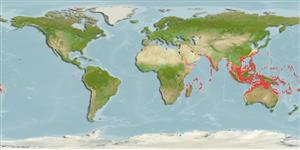>
Mulliformes (Goatfishes) >
Mullidae (Goatfishes)
Etymology: Parupeneus: Latin, parum, parvum = small + Peneus, the name of a river.
More on author: Lacepède.
Environment: milieu / climate zone / depth range / distribution range
Οικολογία
Θαλασσινό(ά) Υφαλόφιλο(α); μη μεταναστευτικό(ά); εύρος βάθους 0 - 125 m (Ref. 90102). Tropical; 30°N - 35°S, 35°E - 124°W (Ref. 54393)
Indo-Pacific: Red Sea and east coast of Africa south to Durban, South Africa, east to the Hawaiian Islands, islands of French Polynesia and the Pitcairn Islands, north to the Ryukyu Islands and Ogasawara Islands, Japan south to Australia.
Μέγεθος / Βάρος / Age
Maturity: Lm ? range ? - ? cm
Max length : 50.0 cm TL αρσενικό/απροσδιόριστο; (Ref. 30573); common length : 35.0 cm TL αρσενικό/απροσδιόριστο; (Ref. 30573); μεγ. δημοσιευμένο βάρος: 2.3 kg (Ref. 4887)
Ραχιαίες άκανθες (συνολικά): 8; Μαλακές ραχιαίες ακτίνες (συνολικά): 9; Εδρικές άκανθες 1; Μαλακές εδρικές ακτίνες: 7. This species is distinguished by the following characters: pectoral rays 16 (rarely 15 or 17); gill rakers 6-7 + 22-26 = 29-33; body depth 3.25-3.8 in SL (body deeper with growth); head length (HL) 2.85-3.1 in SL; snout long, its length 1.61.8 in HL; eye small, the orbit diameter 5.3-8.95 in HL (SL 118-392 mm); barbels very long, 1.15 in HL to longer than head; longest dorsal spine 1.5-1.7 in HL; penultimate dorsal ray 1.1-1.2 in length of last dorsal ray; pectoral-fin length 1.5-1.7 in HL; pelvic-fin length 1.35-1.55 in HL. Colour of large adults yellowish gray, edges of the scales bright blue except ventrally, edges more broadly blue posteriorly; a large, hemispherical, saddle-like, yellow spot covering most of upper half of caudal peduncle; region around eye yellow with radiating short narrow blue bands; caudal fin with longitudinal blue bands; second dorsal and anal fins with narrow oblique blue bands; a second smaller color phase entirely yellow, with dorsal peduncular spot sometimes apparent by being brighter yellow than rest of body (Ref. 54393).
Found on coral (Ref. 58652), rocky, or rubble bottoms of reef flats, lagoons, and seaward reefs (Ref. 3921). Benthopelagic (Ref. 58302). Juveniles form schools, adults usually solitary. Feed primarily on small fishes, crustaceans, peanut worms, shrimps, crabs, octopi, and small gastropods during the day (Ref. 3921). Minimum depth reported taken from Ref. 128797.
Life cycle and mating behavior
Γεννητική Ωρίμανση | Αναπαραγωγή | Γεννοβολία | Αβγά | Γονιμότητα | Προνύμφες
Randall, J.E., 2004. Revision of the goatfish genus Parupeneus (Perciformes: Mullidae), with descriptions of two new species. Indo-Pac. Fish. (36):64 p. (Ref. 54393)
IUCN Red List Status (Ref. 130435)
Threat to humans
Reports of ciguatera poisoning (Ref. 4690)
Human uses
αλιεία: Εμπορικό(ά); αλιεία αναψυχής: ναί; Ενυδρείο: Εμπορικό(ά)
Περισσότερες πληροφορίες
Κοινά ονόματαΣυνώνυμαΜεταβολισμόςΘηρευτέςΟικοτοξικολογίαΑναπαραγωγήΓεννητική ΩρίμανσηΓεννοβολίαΣυναθροίσεις γεννοβολίαςΓονιμότηταΑβγάEgg development
ΑναφορέςΥδατοκαλλιέργειεςΠροφίλ υδατοκαλλιέργειαςΣτελέχοιΓενετικήElectrophoresesΚληρονομικότηταΑσθένειεςΜεταποίησηNutrientsMass conversion
Εργαλεία
Special reports
Download XML
Διαδικτυακές πηγές
Estimates based on models
Preferred temperature (Ref.
123201): 24.5 - 29, mean 27.8 °C (based on 1578 cells).
Phylogenetic diversity index (Ref.
82804): PD
50 = 0.5000 [Uniqueness, from 0.5 = low to 2.0 = high].
Bayesian length-weight: a=0.01230 (0.00783 - 0.01932), b=3.09 (2.96 - 3.22), in cm total length, based on LWR estimates for this species & Genus-body shape (Ref.
93245).
Τροφικό Επίπεδο (Ref.
69278): 4.2 ±0.6 se; based on diet studies.
Ελαστικότητα (Ref.
120179): Μεσαίο(α), ελάχιστος χρόνος για διπλασιασμό πληθυσμού 1,4 - 4,4 έτη (Preliminary K or Fecundity.).
Fishing Vulnerability (Ref.
59153): Moderate vulnerability (40 of 100).
Nutrients (Ref.
124155): Calcium = 23.4 [12.2, 58.4] mg/100g; Iron = 0.3 [0.1, 0.7] mg/100g; Protein = 18 [15, 21] %; Omega3 = 0.132 [0.073, 0.254] g/100g; Selenium = 61.8 [28.3, 147.8] μg/100g; VitaminA = 292 [55, 1,307] μg/100g; Zinc = 0.39 [0.23, 0.74] mg/100g (wet weight);
